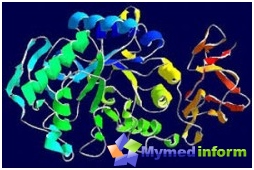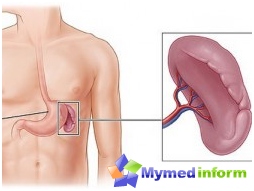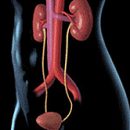Actually under the term «amylase» imply a large group of enzymes responsible for full food digestion.
Varieties of matter. Pancreatic amylaza

Of the three types of amylase - Alpha, Beta and Gamma - Alfa type enzyme is important for health. A substance that is synthesized by saliva glands belongs to alpha-amylases. Enzymes of this group are calcium-dependent and split internal alpha-1,4-bonds in the structure of polysaccharides. The effect of this amylase on the digestion of carbohydrates cannot be called significant: the acidic wedge of the gastric juice almost completely destroys it.
The most responsible stage in the splitting of polysaccharides unfolds in a 12-risen intestine. The main active substances in this process are alpha-amylase, pancreatic juice glucosidase and intestinal juice sucrose. As a result of their joint action, glycogen and starch are converted to Maltose. As soon as any inflammatory process begins in the pancreas, the organ cells begin to produce a specific compound - pancreatic amylase.
The role of the enzyme in the process of digestion
Translated from the Greek «amylon» translated as «starch». The duties of this enzyme include the separation of complex carbohydrates on elementary components. Some fabrics and organs contain a small amount of amylase, but its highest content in the pancreas, where they produce acinquic cells. In the gastrointestinal tract, namely, the 12-point intestine, amylase falls through pancreatic ductures. Minor portions of amylase also produce salivary glands. This means that food comes to the reaction immediately after it is in the mouth of a person.
Learn the level of this specific substance will help blood chemistry and urine. This is possible due to the fact that large volumes of blood pass through the pancreas. Thus, the microscopic dose of amylase penetrates the bloodstream, then enters the kidneys and is excreted in urine.
How do blood for blood test and urine

The amount of this enzyme necessarily increases with the following diseases:
- pancreatitis in acute or aggravated chronic form;
- samples of individual areas of the pancreas (pancreaticosis);
- oncological disease of the pancreas;
- bile sickness (if the lumen of the ducts blocked by a stone);
- renal failure;
- the presence of blood in the stomach;
- spicy appendicitis;
- acute Intestinal obstruction;
- poisoning as a result of alcohol abuse;
- syndrome of the acquired immunodeficiency person;
- Hepatitis C;
- «piggy»;
- acute anthroponous intestinal infection;
- Damage to the integrity of the upper body of the abdominal cavity due to injury.
In addition, increasing alpha-amylase indicators may be provoked by the reception of some drugs: drugs with diuretic action, morphine, oral Contraceptives, Preparations lowering pressure, corticosteroids. At the same time, the state of the pancreas itself remains satisfactory.
High concentration of alpha-amylase in the urine indicates the same pathologies as its elevated blood content, despite the fact that the enzymatic activity of this substance in the urine is much higher than in the blood.
With a minor exceeding the amylase (up to several units) and the patient's good health, worry about nothing. However, if the enzyme indicators are exceeded several times, it indicates the presence of a pathological process in the pancreas. Against the background of strong attacks of acute pancreatitis, the level of alpha-amylase in the blood and urine can be exceeded 100 times. In this case, a person will immediately hospitalize.
The amount of enzyme is reduced under the following pathological conditions:
- Extensive pancreatic leaning;
- Oncological disease of the pancreas of the 4th stage;
- enzyme failure;
- fibergation;
- Recovery after the operation to remove part of the pancreas.
These diseases affect the reduction of alpha-amylase. Low indicators of pancreatic amylase are considered to be a normal physiological phenomenon.
Dependence of amylase indicators on patient age

The normal indicators of the digestive enzyme affect the patient's age, and the quantitative values of the norm for women and men are the same. A minor difference in the results of the analysis is observed in men and women who oversail a 50-year-old frontier. This is explained by the fact that in the period of menopause, the female organism is experiencing a difficult hormonal restructuring.
As already noted, in the course of biochemical analysis of blood, it is possible to determine the concentration of alpha-amylase in the human body. MyMedinform.COM emphasizes your attention that this enzyme with a more detailed study can be divided into amylase P and S-type. P-type amylase is synthesized by the pancreas cells, while S-type amylase produces salivary glands. In the norm of the enzymatic substance of the R-type must be 2 times less than the S-type enzyme. So, depending on the age, the level of alpha-amylase fluctuates within the following limits:
- Children from birth to 12 months - from 5 to 65 units / l;
- from 12 months to 50 years - from 22-25 to 110 units / l;
- from 50 years - from 30 to 130 units / l.
If the results of the biochemical analysis of blood for the content of the digestive enzyme alpha-amylase are unsatisfactory, additional diagnostic procedures can be assigned to the patient to clarify the general picture of its health.









